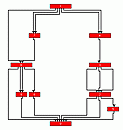Algorithms for Series Parallel Graphs
Graphs can be used to represent relational information. This is the reason why it is often useful to draw graphs in order to visualize this relational information.
|
A series parallel graph is a graph recursively defined as follows. Base case: A graph Let |
|
|
Serial combination: The graph Parallel combination: The graph |
|
LEDA Function for Drawing Series Parallel Graphs
SP_EMBEDDING(): Let G=(V,E) be a series
parallel graph. SP_EMBEDDING() computes a series parallel
embedding of G.
See also:
Manual Entries:
Manual Page Graph Drawing Algorithms
